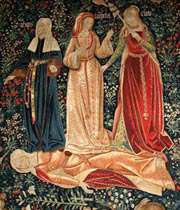Moirae

The Moirae or Moerae (in Greek ?????? – the "apportioners", often called the The Fates), in Greek mythology, were the white-robed personifications of destiny (Roman equivalent: Parcae, euphemistically the "sparing ones", or Fata; also equivalent to the Germanic Norns). The Greek word moira (?????) literally means a part or portion, and by extension one's portion in life or destiny. They controlled the metaphorical thread of life of every mortal from birth to death (and beyond). Even the gods feared the Moirae. Zeus also was subject to their power, as the Pythian priestess at Delphi once admitted; though no classic writing clarifies as to what exact extent the lives of immortals were impacted by the whims of the Fates themselves. A supposed epithet Zeus Moiragetes, meaning "Zeus Leader of the Morae" was inferred by Pausanias from an inscription he saw in the second century CE at Olympia: "As you go to the starting-point for the chariot-race there is an altar with an inscription to the Bringer of Fate. This is plainly a surname of Zeus, who knows the affairs of men, all that the Fates give them, and all that is not destined for them. Zeus does not appear to have been mentioned, and Pausanias' inferred assertion is unsupported in cult practice, though he noted a sanctuary of the Moirae there at Olympia (v.15.4), and also at Corinth (ii.4.7) and Sparta (iii.11.8), and adjoining the sanctuary of Themis outside a city gate of Thebes.
H. J. Rose writes that Nyx ("Night") was also the mother of the Moirae as she was of the Erinyes, in the Orphic tradition.
The three Moirae were:
Clotho (pronounced in English IPA: /?klo??o?]/, Greek ????? IPA: [kl???t???] – "spinner") spun the thread of life from her distaff onto her spindle. Her Roman equivalent was Nona, (the 'Ninth'), who was originally a goddess called upon in the ninth month of pregnancy.
Lachesis (/?l?k?s?s/, Greek ??????? [?l?k?esis] – "allotter" or drawer of lots) measured the thread of life with her rod. Her Roman equivalent was Decima (the 'Tenth').
Atropos (/??tr?p?s/, Greek ??????? [??tropos] – "inexorable" or "inevitable", literally "unturning",[4] sometimes called Aisa) was the cutter of the thread of life. She chose the manner of a person's death. When she cut the thread with "her abhorrèd shears", someone on Earth died. Her Roman equivalent was Morta ('Death').
Mythology
The Moirae were supposed to appear three nights after a child's birth to determine the course of its life. The Greeks variously claimed that they were the daughters of Zeus and the Titaness Themis (the "Institutor") or of primordial beings like Nyx, the Night, Chaos or Ananke, Necessity.
The Moirae, as depicted in an 16th century tapestryIn earlier times they were represented as only a few – perhaps only one – individual goddess.
Homer's Iliad speaks generally of the Moera, who spins the thread of life for men at their birth (xxiv.209), Moera Krataia "strong Moira" (xvi.334) or of several Moerae (xxiv.49). In the Odyssey (vii.197) there is a reference to the Klôthes, or Spinners. At Delphi, only the Fates of Birth and Death were revered. In Athens, Aphrodite, who had an earlier, pre-Olympic existence, was called Aphrodite Urania the 'eldest of the Fates' according to Pausanias (x.24.4).
A bilingual Eteocretan text has the Greek translation ?????? ????? ?????????? (Omosai d-haper Enorkioisi, "But may he swear [these] very things to the Oath-Keepers"). In Eteocretan this is rendered —S|TUPRM?RI?IA, in which M?RI?IA may refer to the divinities the Hellenes knew as the Moirae.
Versions of the Moirae also existed on the deepest European mythological level. It is difficult to separate them from the other Indo-European spinning fate goddesses known as the Norns in Norse mythology and the Baltic goddess Laima and her two sisters. Some Greek mythographers went so far as to claim that the Moirae were the daughters of Zeus— paired with either Ananke or, as Hesiod had it in one passage, Themis or Nyx. Whether or not providing a father even for the Moirae was a symptom of how far Greek mythographers were willing to go, in order to modify the old myths to suit the patrilineal Olympic order, the claim was certainly not acceptable to Aeschylus, Herodotus, or Plato.
The Moirae were usually described as cold, remorseless and unfeeling, and depicted as old crones or hags. The independent spinster has inspired fear rather than matrimony. "This sinister connotation we inherit from the spinning goddess," write Ruck and Staples. See weaving (mythology). Some mythologies depict them instead as the traditional maiden, mother, and crone.
Despite their forbidding reputation, Moirae could be worshipped as goddesses. Brides in Athens offered them locks of hair and women swore by them. They may have originated as birth-goddesses and only later acquired their reputation as the agents of destiny.
They likewise have forbidding appearances (beards), and appear to determine the fates of all individuals.
Compare the Graeae, another set of three old sisters in Greek mythology.
Picture: The Triumph of Death, or The 3 Fates. Flemish tapestry (probably Brussels, ca. 1510–1520). Victoria and Albert Museum, London. The three Fates, Clotho, Lachesis and Atropos, who spin, draw out and cut the thread of life, represent Death in this tapestry, as they triumph over the fallen body of Chastity. This is the third subject in Petrarch's poem "The Triumphs". First, Love triumphs; then Love is overcome by Chastity, Chastity by Death, Death by Fame, Fame by Time and Time by Eternity.
Source: encyclopedia.thefreedictionary.com
Other Links:
Conscription
Dango
Fact of the Day: Hollywood First Film